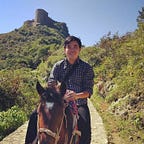New blog name! New city! New language adventures!
Welp, it looks like my 2021 New Year’s Resolution to restart this blog barely lasted two months before falling by the wayside 😅 but hey, at least I have plenty of excuses:
- I got busy at work
- my target of one-post-per-week quickly outpaced the rate at which I could come up with new things to write about
- for a while I decided that Instagram posts were a better medium for the type of linguistic and historical tidbits I was regularly sharing
- and then, well, in October I left New York City — where I had lived, studied and worked for 13 years in total—and am now living in Los Angeles for a to-be-determined amount of time 😳
But anyway, now that I’ve settled in a bit in my new habitat, I figure I should take another shot at reviving this blog. And the first order of business — as you might have already noticed — is a rebranding!
A few weeks after I first started this Medium publication in 2017, I chose the name “Bahasantara” for it— a Sanskrit-Malay word that I made up myself, based on the term Nusantara, a term for the Indonesian archipelago, combined with the word bahasa or bhasha, which means “language” in many languages of South and Southeast Asia.
The name was inspired by my language interests at the time — I had been studying Indonesian and Malay for several months and was really getting into exploring its ties with other languages in Southeast Asia and around the Indian Ocean rim. I also liked the idea of viewing the languages I was studying as a chain of islands linked to one another. A few months later, I even did a 30-day language challenge in Indonesian.
But there was one problem: my language interests have a tendency to drift all over the place, and I soon ended up removing Indonesian from my language-study rotation.
First off, I went to China for a month in early 2018 and spent much of that time focusing on Chinese dialects instead. Then I started a new job as a reporter at a real estate magazine, and also attended the Polyglot Gathering in Bratislava, which had the combined effect of redirecting my language-learning focus back north, towards Russia and Central/Eastern Europe.
The following year, in 2019, I had to brush up on Hebrew for work as well, and then did a deep dive into the Turkic languages — including a trip to Turkey and culminating in my presentation on the Uyghur language at that year’s Polyglot Conference in Fukuoka. After that, and through most of the pandemic, my main focus was on learning Korean.
Although my wandering language interests have occasionally roamed as far as Southeast Asia, Africa, and creole languages of the Americas, I think it’s fair to say that my 15+ years of language learning have generally tended to gravitate toward the central part of the Eurasian landmass — from Russia and East/Central Europe down through the Balkans and Central Asia to the greater Middle East. (Or if you look at it horizontally instead, the area around the historical Silk Road, basically.) This makes a lot of sense considering that the first foreign language I ever really reached a decent level at — and still the only one that I’ve ever studied in-depth in a classroom setting— was Russian.
With that in mind, the name “Bahasantara” has seemed like a less and less fitting name for this blog in the past few years, since Indonesian is at best on the periphery of my core interests and I don’t speak it very well at all. Furthermore, I know plenty of other polyglots who have a better grasp of Southeast Asian languages than I do.
The new blog name, meanwhile, is a reference to 1) the notorious pseudoscientific “Sun Language Theory,” which claims that “all human languages are descendants of one proto-Turkic primal language,” and 2) my last name, which happens to be spelled Sun in Pinyin (although it’s pronounced differently and of course has a different meaning*). In fact I’ve already used this pun a few times before, for the series of posts on Turkic languages in did back in 2019.
(*The surname Sūn/孙/孫 literally means “grandchild” and is pronounced /suən⁵⁵/ in Mandarin, /səŋ⁵³/ in Shanghainese, and /son/ in Korean, where it is also a somewhat common surname.)
Even if my language interests aren’t always focused on Turkic languages per se, I think it’s safe to say that they usually won’t get too far away — Slavic, Iranian, Semitic, Indo-Aryan, Greek/Armenian/Albanian/Georgian etc., and even East Asian and some Germanic languages have all had interactions with Turkic at various points in their history.
So there you have it — this blog is now named “Sun Language Theories”, which should be a bit catchier and easier to remember than “Bahasantara” was, too. And it’s in plural form — Theories—both to make it easier to search for in Google, and because I’m far from having any sort of single unified theory when it comes to language learning.
That’s it for now! For my next post — probably in about two weeks, I’m thinking— I’ll go into a bit more depth regarding my current language studying goals, and my attempt to find a balance between improving a few of my core languages while also making time to dabble in new ones.
After that, once every couple of weeks , I’ll write a bit more about some of the main languages and language families I’ve been working on the most lately. Additionally, since I’ve started teaching myself about machine learning and natural language processing over the past few months, I’m planning to mix in a few posts on those topics as well, or about technologically-assisted language-learning more broadly. Until next time!
